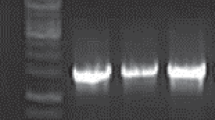Abstract
The metabolism of maltose and the use of electron acceptors has been investigated in strains of lactobacilli which are known to be stable elements in sourdoughs, which, traditionally, have been used for a long time. The metabolic features ofLactobacillus sanfrancisco have been described by us in a previous communication. Similar principles have been detected for the competitiveness ofL. pontis, L. reuteri, L. fermentum andL. amylovorus, as well as species-specific characteristics. Based on these findings the metabolic key reactions have been identified and the use of electron acceptors present in sourdough are presented in a schematic overview. In contrast toL. sanfrancisco, these species can not use oxygen as an electron acceptor, and the length of their lag phase was not affected by agitation. Malate and fumarate were reduced to succinate, and fructose was used, depending on the species, as an electron acceptor, carbon source or both. All heterofermentative sourdough lactobacilli efficiently split maltose using maltose phosphorylase. Glucose was excreted, which induced glucose repression in competing indigenous micro-organisms, without affecting the maltose metabolism of sourdough lactobacilli. Lactobacilli generate additional adenosine 5′-triphosphate (ATP) from acetyl phosphate in the presence of electron acceptors. These special features are suggested to represent a general principle which accounts for the prevalence of specific heterofermentative lactobacilli which are propagated over long periods present in sourdough fermentations.
Similar content being viewed by others
References
Spicher G, Schroder R (1978) Z Lebensm Unters Forsch 167: 342–354
Kline L, Sugihara TF (1971) Appl Microbiol 21: 459–465
Nout MJR, Creemers-Molenar T (1987) Chem Mikrobiol Technol Lebensm 10: 162–167
Böcker G, Vogel RF, Hammes WP (1990) Getreide Mehl Brot 44: 269–274
Vogel RF, Böcker G, Stolz P, Ehrmann M, Fanta D, Ludwig W, Pot B, Kersters K, Schleifer KH, Hammes WP (1994) Int J Syst Bacteriol 44: 223–229
Hamad S, Böcker G, Vogel RF, Hammes WP (1992) Appl Microbiol Biotechnol 37: 728–731
Spicher G, Stephan H (1966) Zentralbl Bakteriol Parasitenk Infektionskr Hyg Abt II 120: 699–701
Lönner C, Welander T, Molin N, Dostalek M, Blickstad E (1986) Food Microbiol 3: 3–12
Spicher G (1987) Z Lebensm Unters Forsch 184: 300–303
Strohmar W, Diekmann H (1992) Z Lebensm Unters Forsch 194: 536–546
Sugihara TF, Kline L, Miller MW (1971) Appl Microbiol 21: 456–458
Medcalf DG, Cheung PW (1971) Cereal Chem 48: 1–8
Saunders RM, Ng H, Kline L (1972) Cereal Chem 49: 86–91
Spicher G, Schröder R, Schöllhammer K (1979) Z Lebensm Unters Forsch 167: 77–81
Galli A, Franzetti L, Fortina MG (1987) Microbiol Aliments Nutr 5: 3–9
Barber S, Baguena R, Benedito de Barber C, Martinez-Anaya MA (1991) Z Lebensm Unters Forsch 192: 46–52
Martinez-Anaya MA, Pitarch B, Bayarri P, Benedito de Barber C (1990) Cereal Chem 67: 85–91
Stolz P, Böcker G, Vogel RF, Hammes WP (1993) FEMS Microbiol Lett 109: 237–242
Wood BJB, Rainbow C (1961) Biochem J 78: 204
Stolz P, Böcker G, Hammes WP, Vogel RF (1995) Z Lebensm Unters Forsch 201: 91–96
Spicher G, Rabe E (1983) Z Lebensm Unters Forsch 176: 190–195
Röcken W, Rick M, Reinkemeier M (1992) Z Lebensm Unters Forsch 195: 259–263
Martinez-Anaya M, Llijn ML, Macias MP, Collar C (1994) Z Lebensm Unters Forsch 199: 186–190
Condon S (1983) Ir J Food Sci Technol 7: 15–29
Klempp J, Regula E, Wassermann L (1982) Z Lebensm Unters Forsch 175: 403–405
Kandler O (1983) J Antonie van Leeuwenhoek 49: 209–224
Condon S (1987) FEMS Microbiol Rev 46: 269–280
Starrier JR, Stoyla BO (1967) Appl Microbiol 15: 1025–1030
Peinado JM, Barbero A, van Uden N (1987) Appl Microbiol Biotechnol 26: 154–157
Mohammed SI, Steenson LR, Kirleis AW (1991) Appl Environ Microbiol 57: 2529–2533
Spicher G, Schröder R, Stephan H (1980) Z Lebensm Unters Forsch 171: 119–124
Veiga-Da-Cunha M, Firme P, San Romáo MV, Santos H (1992) Appl Environ Microbiol 58: 2271–2279
Neubauer H, Glaasker E, Hammes WP, Poolman B, Konings WN (1994) Bacteriol 176: 3007–3012
Author information
Authors and Affiliations
Rights and permissions
About this article
Cite this article
Stolz, P., Vogel, R.F. & Hammes, W.P. Utilization of electron acceptors by lactobacilli isolated from sourdough. Z Lebensm Unters Forch 201, 402–410 (1995). https://doi.org/10.1007/BF01192742
Received:
Revised:
Issue Date:
DOI: https://doi.org/10.1007/BF01192742




